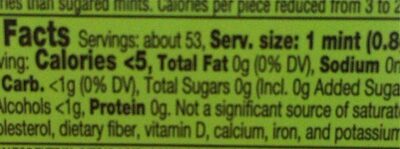Ice Breakers Cherry Limeade - Hershey - 42g
This product page is not complete. You can help to complete it by editing it and adding more data from the photos we have, or by taking more photos using the app for Android or iPhone/iPad. Thank you!
×
Barcode: 0034000722747 (EAN / EAN-13) 034000722747 (UPC / UPC-A)
Quantity: 42g
Brands: Hershey
Categories: Snacks, Sweet snacks, Confectioneries, Candies, Chewing gum, Sugar-free chewing gum
Origin of ingredients: United States
Countries where sold: United States
Matching with your preferences
Health
Food processing
Additives
Ingredients analysis
The analysis is based solely on the ingredients listed and does not take into account processing methods.
Serving size:
0.8g
⚠
️Serving size is too small (5 g / 5 ml or less) to calculate 100 g / 100 ml values and perform any further nutritional analysis
Environment
Packaging
Transportation
Threatened species
Report a problem
Data sources
Product added on by kiliweb
Last edit of product page on by availableattheend.
Product page also edited by averment, openfoodfacts-contributors, wolfgang8741, yuka.sY2b0xO6T85zoF3NwEKvlnx4Y97xjhPBEibmllHb5oupL7q5XuB1xoj8Hao.
If the data is incomplete or incorrect, you can complete or correct it by editing this page.








